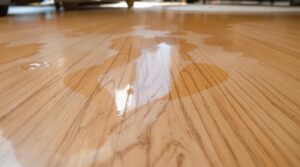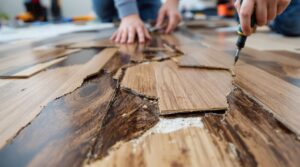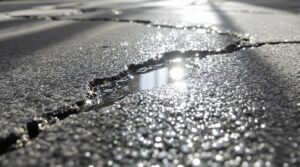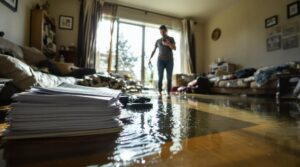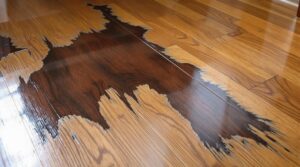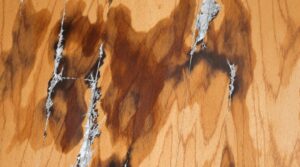When water seeps through laminate flooring, immediate action is critical. The first step involves locating and stopping the water source, followed by removing standing water with a wet-dry vacuum within one hour. Strategic placement of dehumidifiers and fans helps accelerate drying. Baseboards should be removed to enhance airflow, and moisture levels require consistent monitoring. Professional assessment becomes necessary if visible buckling, warping, or deep water penetration occurs. Understanding the full scope of damage prevention and recovery options guarantees maximum protection of laminate floors.
Key Takeaways
- Remove standing water immediately using a wet-dry vacuum to prevent further damage to the laminate flooring.
- Deploy dehumidifiers and high-volume fans within 2 hours to accelerate the drying process.
- Remove baseboards to enhance airflow and check for mold growth in affected areas.
- Use moisture meters to assess damage extent and consider professional help if buckling or warping occurs.
- Document all visible damage and contact your insurance company promptly to initiate a claim.
Understanding the Signs of Water Seepage in Laminate Floors
When water seeps into laminate flooring, several distinct signs emerge that indicate potential damage to the material's structural integrity.
Early moisture detection involves identifying soft, spongy areas that develop underfoot, along with warping or bubbling on the surface. Homeowners should listen for hollow sounds when tapping the floor or squeaking noises during walking, as these indicate water has penetrated beneath the laminate. High humidity levels can accelerate moisture absorption and lead to severe structural issues.
Visual indicators vital for effective flooring maintenance include swelling around seams, buckling where boards lift from the subfloor, and the formation of bubbles from trapped moisture.
Discoloration manifests as dark spots, staining, or cloudy patches on the surface. These signs often appear progressively, making regular inspection essential for identifying water damage before it becomes severe enough to compromise the entire floor system.
Common Causes of Water Seepage Under Laminate Flooring

Understanding the root causes of water seepage helps homeowners prevent and address laminate floor damage effectively. Four primary factors contribute to water infiltration beneath laminate flooring: everyday spills, humidity issues, plumbing problems, and external flooding.
Daily incidents like spilled beverages or pet water bowls can lead to water damage when not promptly addressed. Installing quality underlayment barriers provides essential protection against moisture infiltration. High humidity and inadequate subfloor sealing allow moisture buildup from below, while leaky appliances and faulty plumbing create persistent water exposure.
Natural disasters and flooding events pose severe risks to flooring integrity. Proper flooring maintenance requires immediate attention to spills, regular inspection of plumbing systems, and humidity control through dehumidification.
In flood-prone areas, water-resistant laminate options and professional installation with proper sealing can greatly reduce the risk of water damage.
Immediate Steps to Take When Water Seeps Through
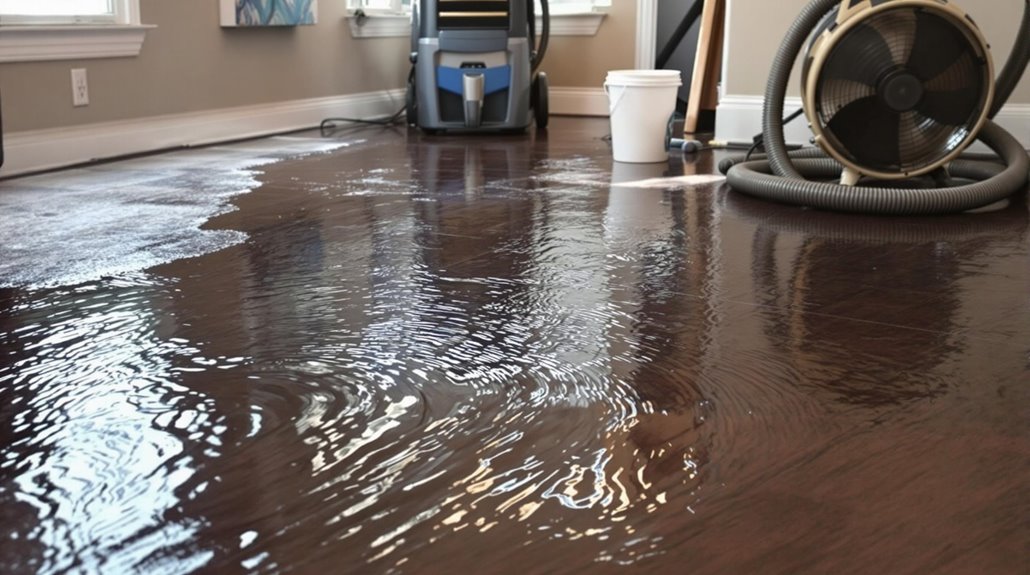
Swift action proves essential when water seeps through laminate flooring, as immediate intervention can prevent extensive damage and costly repairs. Upon discovering a water leak, immediately locate and stop the water source, then conduct a thorough flooring inspection to assess the extent of seepage. Regular inspections can reveal musty odors which often indicate moisture problems beneath the surface. Additionally, if wet spots or discoloration are found, it is crucial to lift any affected planks to allow for proper drying and ventilation. Ignoring these signs can lead to more severe issues, including mold growth and water damage in concrete floors below the laminate. By taking prompt measures to address water exposure, homeowners can safeguard their investment and maintain the integrity of their flooring.
| Action | Priority Level | Timeline |
|---|---|---|
| Stop Water Source | Critical | Immediate |
| Remove Standing Water | High | Within 1 Hour |
| Deploy Drying Equipment | High | Within 2 Hours |
Use a wet-dry vacuum to extract surface water, then deploy dehumidifiers and fans to accelerate drying. Remove baseboards to enhance airflow and carefully lift affected laminate planks if necessary. Monitor humidity levels consistently and consider professional intervention if water damage appears extensive or if specialized equipment is required for proper restoration.
Effective Methods for Drying Out Laminate Floors
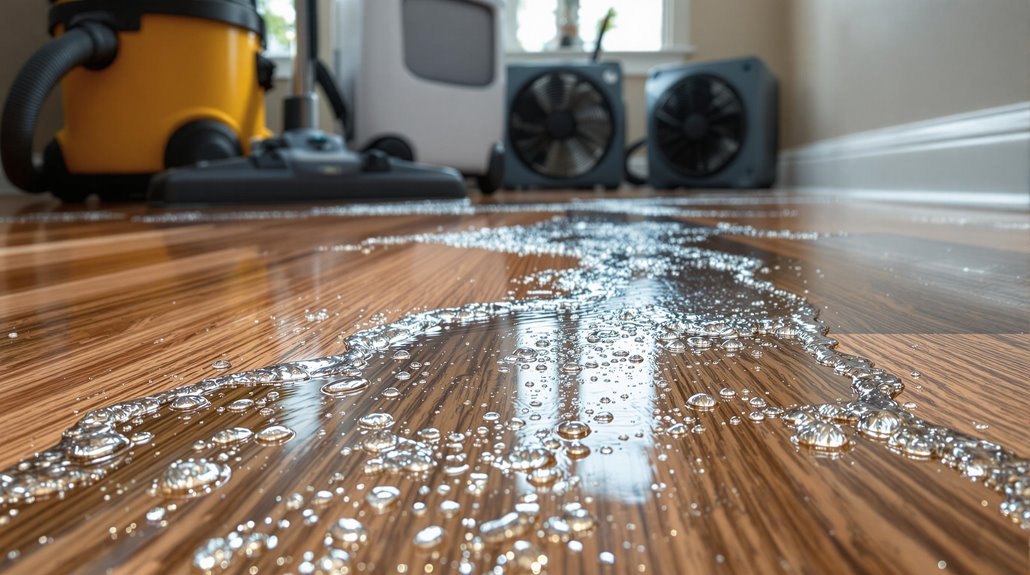
Proper drying techniques can salvage water-damaged laminate flooring when implemented systematically and promptly.
The process begins with removing standing water using wet/dry vacuums or water extraction tools, followed by removing baseboards to enhance airflow. Strategic placement of commercial dehumidifiers and high-volume fans accelerates the drying process.
Moisture assessment is vital throughout the procedure. Using moisture meters helps monitor both the laminate surface and subflooring conditions.
In severe cases, lifting the flooring or drilling strategic holes may be necessary to facilitate thorough drying underneath. The drying process must continue until moisture readings indicate complete restoration to acceptable levels.
Regular monitoring for potential mold growth and subfloor damage guarantees the effectiveness of the drying techniques and helps prevent secondary complications.
Professional Vs DIY Water Damage Repair
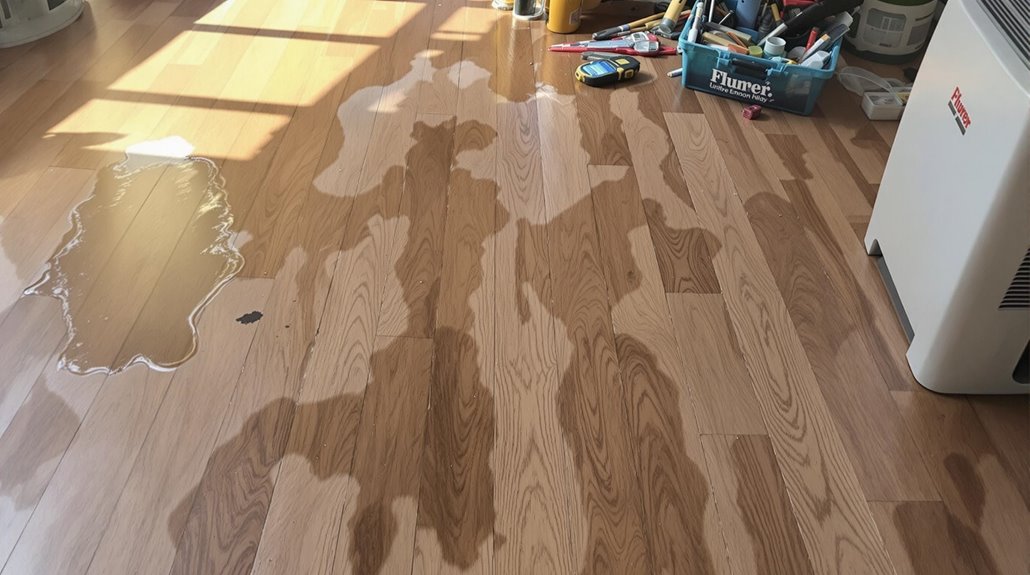
Homeowners must evaluate both the scope of water damage and their technical capabilities when deciding between DIY repairs and professional intervention for laminate flooring issues.
While DIY repairs may initially seem cost-effective, professional services offer specialized equipment, expertise, and time-efficient solutions that often prove more economical in preventing long-term damage.
The decision timeline typically hinges on factors such as the extent of water penetration, presence of mold, and whether structural damage exists, with professional services averaging 2-3 days for completion versus potentially weeks for DIY efforts.
When To Call Experts
Determining when to seek professional help for water-damaged laminate flooring involves evaluating several critical factors. An expert evaluation becomes necessary when the damage extends beyond superficial issues, requiring extensive damage assessment and specialized intervention.
Key indicators that necessitate professional assistance include:
- Visible buckling or warping of multiple laminate planks
- Detection of mold growth beneath the flooring surface
- Deep water penetration affecting the subfloor structure
- Failed attempts at DIY repairs that worsen the condition
- Continuous water seepage from unidentified sources
Professional intervention guarantees thorough remediation through advanced equipment and expertise.
Technicians can address structural concerns, implement proper drying techniques, and prevent secondary issues like mold growth. Their extensive approach not only resolves immediate problems but also safeguards against future complications, making it a prudent investment for severe water damage scenarios.
Time And Cost Comparison
Making an informed decision between DIY and professional water damage repair requires careful evaluation of both time investment and financial implications.
While DIY repairs may seem cost-effective initially, repair timelines can extend considerably due to the complex process of cleaning, drying, and restoration.
A thorough cost analysis reveals that professional services, despite higher upfront expenses, often prove more economical long-term.
Professionals complete repairs efficiently with specialized equipment and expertise, minimizing disruption and preventing secondary damage.
DIY attempts may require multiple corrections and risk inadequate repairs, potentially leading to recurring issues.
Additionally, professionals can identify underlying problems and implement lasting solutions.
The choice ultimately depends on damage severity, urgency, and the property owner's technical capabilities, with professional services generally offering better value for extensive water damage.
Prevention Strategies for Future Water Damage
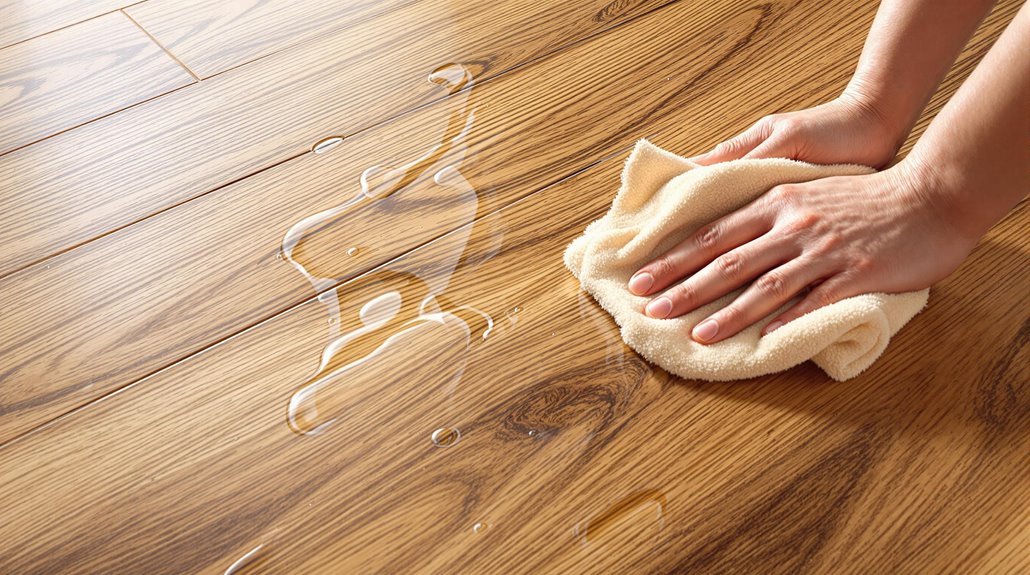
To effectively protect laminate flooring from water damage, implementing thorough prevention strategies is essential both during installation and throughout the floor's lifetime.
Extensive moisture control begins with proper installation techniques and continues with diligent laminate maintenance practices.
Key preventive measures include:
- Installing moisture barriers and appropriate underlayment before laying the flooring
- Maintaining indoor humidity levels between 30% and 60%
- Implementing immediate spill cleanup protocols
- Applying and regularly maintaining waterproof sealants on surfaces and joints
- Using protective mats in high-risk areas like entryways and sinks
Professional installation combined with consistent maintenance greatly reduces the risk of water damage.
Regular inspections help identify potential issues before they escalate, while proper cleaning techniques using minimal moisture preserve the floor's integrity.
Installing leak detection systems provides an additional layer of protection against unexpected water issues.
Since water damage claims are among the most common insurance claims, proper prevention can help avoid costly repairs and premium increases.
Essential Tools and Materials for Water Damage Recovery
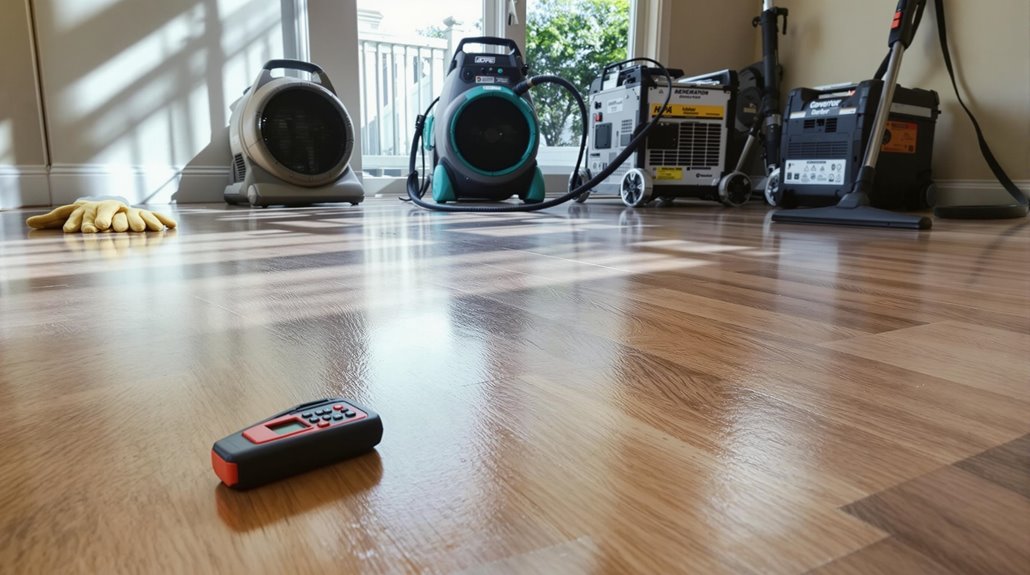
Professional water damage recovery requires four essential categories of tools and equipment: detection instruments, water extraction machinery, drying equipment, and cleaning supplies.
Initial moisture detection relies on specialized tools like moisture meters, thermal imaging cameras, and hygrometers to accurately assess damage extent and monitor progress.
Water extraction equipment includes submersible pumps, truck-mounted units, and wet vacuums for efficient water removal.
Restoration techniques then focus on thorough drying using industrial air movers, dehumidifiers, and desiccants to prevent secondary damage and mold growth.
Air filtration devices and HEPA vacuums maintain air quality during the process.
The final phase requires cleaning and sanitization tools, including pressure washers, fogging devices, and appropriate disinfectants.
Throughout the recovery process, proper PPE guarantees worker safety while portable generators provide reliable power for all equipment.
The Benefits Of Consulting A Public Adjuster
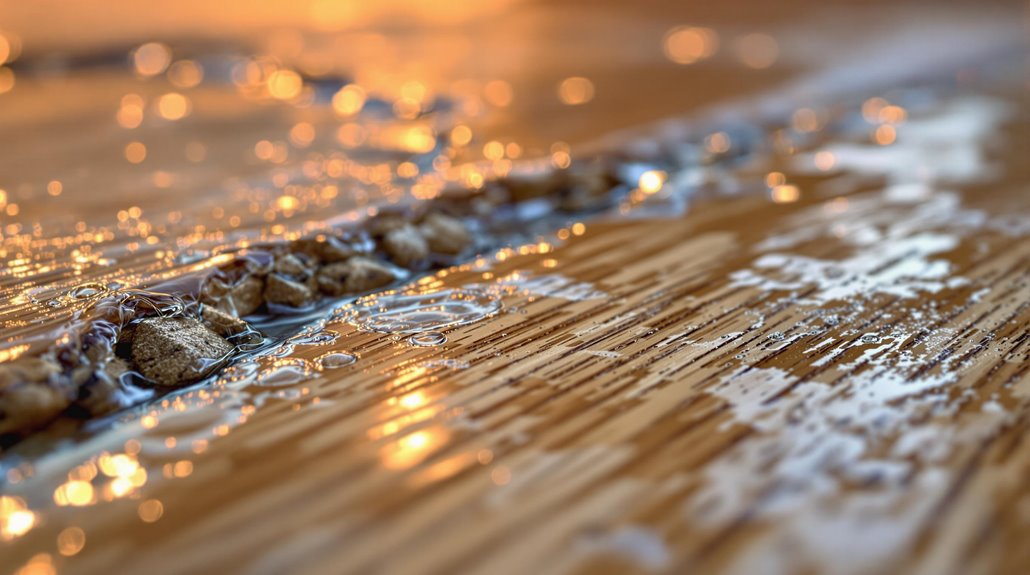
When water damage affects laminate flooring, a public adjuster's expertise in insurance claims proves invaluable for securing appropriate compensation.
Their objective damage assessment methods and detailed documentation help identify both visible damage and potential long-term issues that property owners might overlook.
Through their established relationships with insurance companies and understanding of policy terms, public adjusters streamline the claims process while typically achieving higher settlement amounts compared to self-filed claims.
Studies have shown that homeowners who engage certified public adjusters can receive up to 500% higher settlements for non-catastrophic water damage claims.
Expertise In Insurance Claims
Public adjusters bring invaluable expertise to water damage insurance claims through their thorough understanding of policies, procedures, and industry practices. Their insurance policy interpretation skills guarantee extensive coverage evaluation, while their claims process optimization techniques streamline the entire procedure.
Key areas of expertise include:
- Detailed analysis of policy terms and coverage limitations
- Strategic documentation of water damage evidence and repair costs
- Professional negotiation with insurance carriers
- Accurate assessment of both visible and hidden water damage
- Compliance with claim filing deadlines and requirements
Their professional knowledge extends beyond basic claim filing, encompassing complex aspects of water damage assessment, policy interpretation, and settlement negotiation.
This expertise often results in more thorough claim documentation and frequently leads to higher settlement amounts for property owners.
Unlike insurance adjusters who work for carriers, public adjuster fees are based on a percentage of the final settlement, typically up to 10%, ensuring their interests align directly with the policyholder's success.
Objective Damage Assessment
Thorough damage assessment forms the cornerstone of successful water damage claims, making the expertise of public adjusters invaluable to property owners. Through extensive damage evaluation techniques and advanced diagnostic tools, these professionals uncover hidden issues that often escape untrained observation.
| Assessment Area | Tools Used | Benefits |
|---|---|---|
| Surface Damage | Moisture Meters | Precise Moisture Detection |
| Structural Impact | Thermal Imaging | Hidden Water Location |
| Mold Growth | UV Detection | Early Problem Prevention |
| Secondary Effects | Digital Documentation | Complete Claim Support |
Public adjusters employ scientific methods to document every aspect of water damage, from visible surface deterioration to concealed structural compromises. Their systematic approach guarantees that insurance claims accurately reflect the full scope of damage, incorporating both immediate and potential long-term consequences of water seepage through laminate flooring. Working on a contingency fee basis, public adjusters are motivated to secure the highest possible settlement for property owners facing water damage issues.
Streamlined Claim Process
Engaging a public adjuster considerably streamlines the insurance claims process for water-damaged laminate flooring, transforming a potentially complex ordeal into a manageable sequence of steps.
These professionals guarantee thorough claim documentation while maintaining strict policy compliance throughout the process.
With less than 5% of policyholders aware of public adjusters' services, many miss out on valuable claim assistance.
Public adjusters facilitate efficient resolution through:
- Precise management of all insurance-related paperwork and documentation requirements
- Direct handling of communications with insurance carriers, eliminating confusion
- Expert navigation of policy terms and conditions to prevent settlement delays
- Professional oversight of the entire claims process, reducing policyholder stress
- Swift response to insurance company queries and requests for additional information
This systematic approach accelerates claim resolution while allowing property owners to focus on addressing their water-damaged flooring and implementing necessary remediation measures, rather than getting overwhelmed by complex claims procedures.
Higher Claim Payouts & Settlements
Expertise in insurance claims consistently yields higher settlement amounts when property owners consult public adjusters for water-damaged laminate flooring claims.
Through specialized claim strategies and detailed damage assessments, public adjusters identify both visible and concealed water damage that might otherwise go unnoticed.
These professionals employ effective negotiation tactics with insurance companies, leveraging their in-depth knowledge of policies and procedures to secure maximum compensation.
Working on a contingency basis of up to 10% of the settlement, public adjusters are inherently motivated to obtain ideal results.
Their objective assessment and thorough documentation of water damage, combined with their understanding of restoration costs, guarantees that policyholders receive fair settlements that adequately cover necessary repairs and replacements to their laminate flooring.
About The Public Claims Adjusters Network (PCAN)

The Public Claims Adjusters Network (PCAN) represents a professional consortium of licensed insurance claim specialists who advocate for policyholders during insurance settlements.
Their Public Adjuster Responsibilities encompass thorough claim assessment, documentation, and Claim Negotiation Strategies designed to maximize insurance settlements for property damage.
PCAN delivers value through:
- Professional evaluation of property damage, including hidden impacts
- Documentation and estimation of losses using industry-standard methodologies
- Strategic negotiation with insurance carriers to optimize claim settlements
- Emergency mitigation and temporary housing coordination services
- Continuous support from initial consultation through final settlement
Operating under strict regulatory oversight, PCAN maintains transparency throughout the claims process, with all contracts and fee structures approved by the Insurance Department.
Their service model guarantees clients receive expert representation without upfront costs, as fees are derived solely from successful claim settlements.
Frequently Asked Questions
How Long Does Water-Damaged Laminate Flooring Typically Last After Repairs?
Repaired water-damaged laminate flooring typically lasts 6-24 months, depending on damage severity, repair quality, and environmental conditions. Even with professional repair, structural integrity often remains compromised long-term.
Can Water-Damaged Laminate Flooring Be Sold or Recycled?
Water-damaged laminate flooring cannot typically be recycled or resold due to delamination and structural compromise. The material's composition after water damage makes it unsuitable for flooring recycling programs.
Does Homeowner's Insurance Cover Water Seepage Through Laminate Floors?
Walking on thin ice, homeowner's insurance typically doesn't cover gradual water seepage through laminate floors. However, sudden water damage from burst pipes or leaks may qualify for insurance claims.
What Chemicals Are Safe to Use When Cleaning Water-Damaged Laminate Flooring?
pH-neutral cleaning solutions, diluted white vinegar (1:3 ratio with water), and biodegradable cleaners like Black Diamond are chemically safe for treating water-damaged laminate flooring. Avoid harsh acidic or alkaline substances.
How Much Does Laminate Floor Water Damage Decrease Home Resale Value?
Water-damaged laminate flooring typically reduces home value by 10-25%, depending on damage severity. Market perception of moisture issues considerably impacts buyer interest, potentially extending property listing duration and decreasing final sale price.
References
- https://watersfault.com/7-signs-that-your-laminate-floor-has-water-damage/
- https://www.ecfunderlayment.com/3-sources-of-moisture-that-can-disrupt-your-laminate-flooring/
- https://dokumen.pub/the-oxford-handbook-of-media-technology-and-organization-studies-9780198809913-0198809913.html
- https://www.aaflooringdirect.com/blog/articles/how-to-remove-water-under-laminate-floor
- https://claudebrowns.com/how-to-prevent-repair-water-damage-to-laminate-flooring/
- https://tekaflooring.co.uk/blog/can-water-damage-laminate-flooring/
- https://superiorrestore.com/laminate-floor-water-damage-causes-repair/
- https://www.thespruce.com/can-you-get-laminate-flooring-wet-1822254
- https://www.bobvila.com/articles/signs-of-water-damage-under-floor/
- https://www.nielsenbrosflooring.com/blog/articles/dealing-with-water-under-laminate-flooring-causes-prevention-and-solutions
